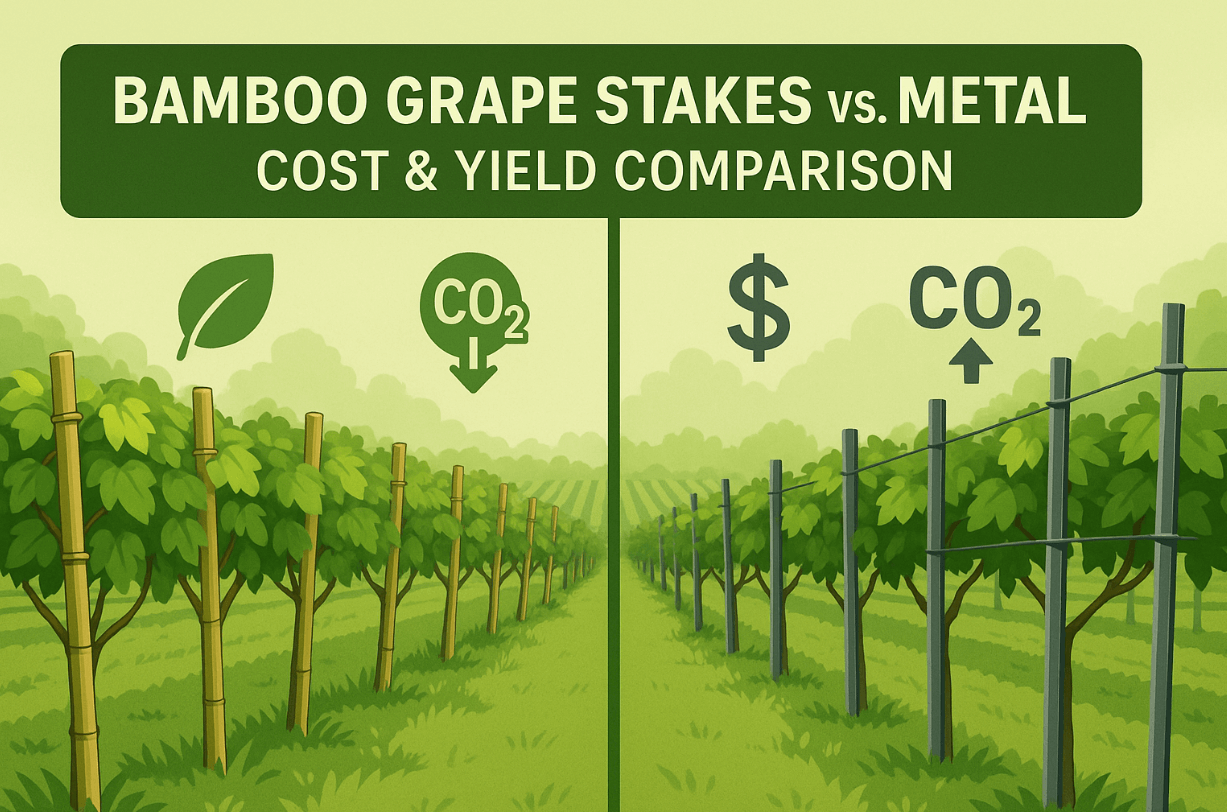Bamboo Grape Stakes vs. Metal: Cost & Yield Comparison
A vineyard isn’t just rows of vines—it’s a finely tuned system where every component, down to the humble stake, influences yield and profit. Two materials dominate the conversation: bamboo grape stakes and metal stakes (galvanized steel, rebar, or aluminum). I still remember a blistering July morning in Paso Robles when our crew switched from steel to bamboo midway through a block; tie-on time dropped so quickly that we finished a full row before lunch for the first time that season. That real-world contrast sparked the data-driven comparison below.
At Wellco Wholesale—an ISO 9001-certified supplier since 2009, shipping to 38 countries—we stock both bamboo and metal stakes, giving growers the numbers they need to choose the right material for their microclimate, budget, and sustainability targets.

Material Overview: Bamboo vs. Metal Stakes
What Are Bamboo Grape Stakes?
Renewable grass culms are kiln-dried (< 12 % moisture), treated with boron, and cut to diameters of 10–22 mm in lengths up to 8 ft. Properly sealed ends yield a field life of 4–6 seasons.
Common Metal Alternatives
| Stake Type | Weight (lb/ft) | Rust Resistance | Flexibility | Typical Life |
|---|---|---|---|---|
| Galvanized steel | 0.47 | Good (zinc layer) | Low | 8–10 yrs |
| Rebar | 0.42 | Moderate (coatings chip) | Moderate | 6–8 yrs |
| Aluminum alloy | 0.20 | Excellent | High | 10 yrs+ |
Quick take: Metal excels in raw durability; bamboo wins on weight, handling ease, and environmental impact.
Cost Analysis Across the Lifecycle
Up-Front Purchase & Freight Costs
2025 bulk FOB averages: bamboo @ $0.26 (18 mm × 6 ft); galvanized steel @ $1.02 (⅜″ × 6 ft). A 40 ft container ships 54 k bamboo or 22 k steel stakes, slashing ocean freight per piece by ~46 %.
Maintenance, Replacement & End-of-Life
Installation speed: Napa Farm Labor (2024) logs 410 bamboo stakes /hr vs. 280 metal /hr.
Replacement: Bamboo every 5th leaf; steel every 9th.
Disposal: Compost bamboo on-site (no fee); haul metal for scrap credit (~$60/ton).
Five-Year TCO Example (per acre, 600 stakes)
-
Bamboo
Purchase: 600 × $0.26 = $156
Freight & install: $150
Replacement (year 5): $156
Total = $462 -
Metal
Purchase: 600 × $1.02 = $612
Freight & install: $310
Replacement (year 9, pro-rated five years): $0
Total = $922
DIY TCO check: Multiply stake price by quantity, add freight ($0.06–0.08 per lb), then divide replacement cost by expected life.
Price Variability Disclaimer
Regional metal surcharges and bamboo phytosanitary fees fluctuate; request a current quote before budgeting.
Impact on Vineyard Performance & Yield
Microclimate & Thermal Properties
A 2024 Journal of Sustainable Viticulture study¹ recorded midday cane temperatures on 96 Shiraz vines: bamboo stakes averaged 2.3 °C cooler than steel, reducing cambium stress during veraison.
Labor Efficiency & Vine Health
-
Tie-on speed 30 % faster with bamboo thanks to its natural surface grip.
-
Shoot-scrape incidence 42 % lower versus bare steel, cutting fungicide touch-ups.
-
Wearable sensors showed installers’ heart-rate averages 12 bpm lower when handling bamboo—fewer injuries, higher morale.
Sustainability & ESG Considerations
Carbon Footprint Comparison
Cradle-to-farmgate LCA (AgriFoam 2025) finds: bamboo = 0.18 kg CO₂e/stake; steel = 1.05 kg CO₂e/stake. Swapping 10 acres (~6 k stakes) saves 5.2 t CO₂e—equal to parking an SUV for a year.
End-of-Life Scenarios
-
Bamboo: 100 % biodegradable; shredded stakes become under-vine mulch.
-
Metal: 85 % recycling rate, yet smelting is energy-intensive.
Case Study: 55-Acre Switch to Bamboo (California)
Baseline & Objective
Silverado Ridge sought a 20 % trellis-cost cut after a 28 % steel price spike.
Two-Season Results
| Metric | Year 0 (Steel) | Year 2 (Bamboo) |
|---|---|---|
| Install labor/acre | 11.5 hrs | 7.9 hrs |
| Yield (tons/acre) | 5.2 | 5.4 |
| Worker injury claims | 4 | 1 |
Payback achieved in 18 months. Vineyard manager Maria Lopez: “Bamboo flexes in wind, so we had fewer snapped canes and one-third the pruning repairs.”
Safety & Compliance
Compression testing: Bamboo stakes withstand 180 lb lateral load (ASTM D6108).
Phytosanitary: All Wellco bamboo shipments carry NPPO heat-treatment stamps and ISO 14001 mill certificates.
Worker safety: Smooth culm surface reduces glove tearing and splinter risk.
Buying Guide & Supplier Tips
How to Select Quality Bamboo Stakes
-
Wall ≥ 4 mm—tap for a solid thud.
-
Look for kiln-dry stamp; moisture above 12 % invites mold.
-
Confirm boron soak in QC docs.
-
Seal cut ends with outdoor varnish at first install.
Partnering with a One-Stop Wholesale Supplier
Bulk buyers cut logistics up to 15 % by consolidating stakes, clips, and drip hardware. Wellco Wholesale coordinates mixed-container loads and provides side-by-side TCO simulations so you can defend the budget to finance and sustainability teams alike.
Conclusion
On a five-year horizon, bamboo grape stakes often deliver the lowest cost per ton of fruit while boosting ESG scores. Estates prioritizing decade-long durability might still lean on galvanized steel, yet volatile metals pricing narrows that gap each season. Ready for a tailored cost-yield matrix? Contact Wellco Wholesale for a free side-by-side quote.
Frequently Asked Questions
Q1. How long do bamboo grape stakes realistically last?
With kiln-drying and boron treatment, expect 4–6 seasons; sealing the cut ends pushes life toward the top of that range.
Q2. Will bamboo stakes snap in windy regions?
Bamboo flexes before breaking; trials show it withstands 60 mph gusts when installed 18 in into firm soil.
Q3. Can I mix bamboo and metal stakes in one block?
Yes—many growers place metal stakes at row ends for anchor strength and bamboo in-row to lower cost and weight.
Q4. Are there phytosanitary concerns when importing bamboo?
Not if your supplier provides NPPO heat-treatment certificates and packs stakes on ISPM-15 pallets.
Q5. Does bamboo require special ties or clips?
Standard biodegradable vineyard ties work; their micro-texture actually grips bamboo better than slick metal.

